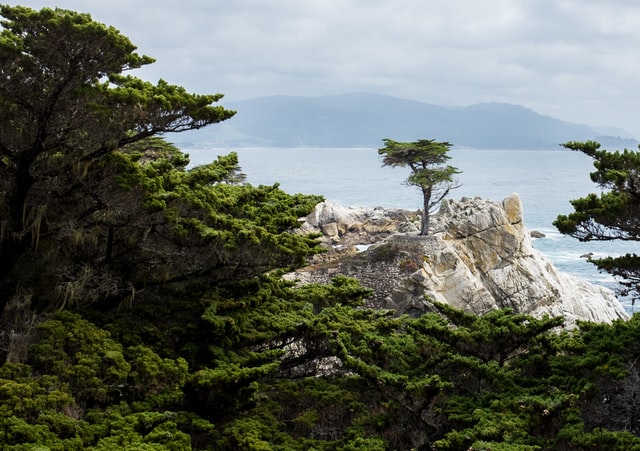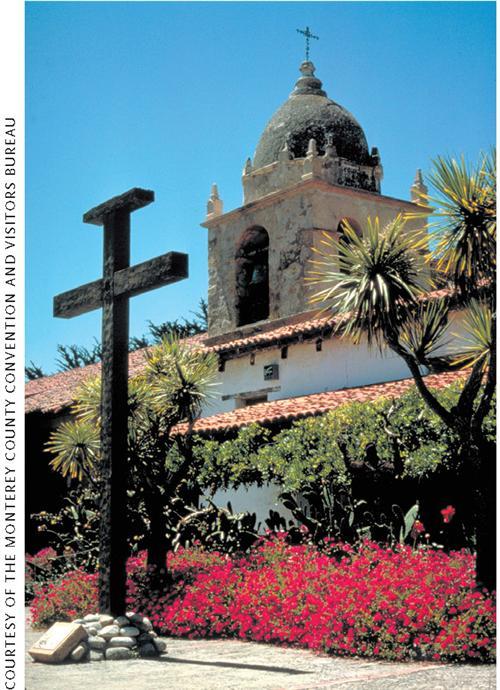
It’s a rare feat today to travel through a California city without encountering boulevards named El Camino Real or Camino de la Reina. These names remind us of the state’s original European heritage: Spanish. Fifty years after Christopher Columbus sailed the ocean blue, Juan Rodríguez Cabrillo—a Portuguese sailor sent by Spain—and his flagship San Salvador sailed into one of the world’s most beautiful natural harbors, now known as San Diego. Other cities along the coast adopted Spanish names, which have long outlasted Spanish rule. In 1846, American settlers proclaimed independence from Mexico and established the California Republic. While Mexico was ceding California to the United States in 1848, gold was discovered. By 1854, more than 300,000 gold seekers had rushed West and further diluted (but didn’t wipe out) the state’s Spanish/Mexican flavor. The transcontinental railroad, Great Depression migration and post-WWII industrial boom continued to boost the state’s population. Today, California boasts nearly 39 million people. More than a third of the state’s population claims Hispanic heritage, and you still can see the influence of California’s early Spanish and Mexican roots.
Census records
Before California became the 31st state, Spanish censuses (padrones) counted residents in several cities, including Los Angeles, San Luis Obispo and San Antonio. These enumerations began in 1790. Find an online transcription of the 1790 census here and an index to Spanish mission censuses of 1796 to 1798 at subscription site Ancestry.com. The Family History Library (FHL) has the early padrones on microfilm, including the Los Angeles counts of 1790, 1836 and 1844. California’s 1852 statewide census includes details on each person, such as birthplace and last residence. You’ll find this census at the California State Library (CSL), on FHL microfilm and at Ancestry.com. The California State Archives and FHL have some city census records from 1897 to 1938. You can get federal census records (except 1890, which was mostly destroyed) beginning in 1850, the first US census to cover California, on Ancestry.com, MyHeritage and Findmypast. The free FamilySearch has many US census indexes and records. Index results may link to census images on fee-based partner sites. California’s Great Registers—county voter-registration lists dating back to 1866—are useful supplements to censuses (and a helpful substitute for the lost 1890 census). These lists were compiled every two years, and include data, such as name, age, place of birth, address, occupation and sometimes physical description. Note that they list only men until women obtained suffrage. The CSL has registers from 1866 to 1944, but you can also find them on Ancestry.com and FamilySearch (1866-1910), and on microfilm at major genealogy libraries.
Libraries
Your key to finding records in California libraries is the Online Archive of California, which has more than 20,000 searchable collection guides and 220,000 digital images. Golden State researchers should plan a trip to the CSL. It offers a wealth of family history materials, including telephone directories (starting in 1899), city and county directories (as early as 1850), biographical dictionaries, and county histories. Researchers also can access microfilms of California newspapers, including at least one title from every county. Be sure to check digitized newspaper websites like Newspapers.com, GenealogyBank and Chronicling America for papers from the counties and towns where your California kin lived. If your family arrived in California before 1860, check the Pioneer Card File. You also may find mention of your ancestor in the California Information File, with 1.4 million references dating from the 1840s, or indexes with 2.5 million citations from San Francisco newspapers. Round out your CSL visit by going through its collection of Daughters of the American Revolution transcriptions of cemetery records, Los Angeles County baptisms (some as early as 1771), pioneer obituaries, Bible records, early wills and veterans grave registrations. (Some of these are available through the FHL, too.) The state archives in Sacramento has military, prison and county records, with copies for many records on microfilm at the FHL. See the archives’ family history resources here.
Vital records
Churches kept the first California birth records; counties took on the task later. Monterey County, for example, has some births as early as 1824. Statewide registration of births, marriages and deaths didn’t begin until 1905. Request informational copies (instead of the restricted authorized ones) of birth, death or marriage certificates by mail through the California Department of Public Health Office of Vital Records. See the website for details, downloadable forms and processing times, which can exceed six months. Requesting through county offices may be faster. Copies of birth and death records and public marriage licenses can also be requested from the issuing county recorder’s office, and divorce records from the issuing county superior court. You can access several California vital records indexes online, primarily at FamilySearch.org, Ancestry.com, Archives.com and VitalSearch.com. There are some microfilmed indexes, marriage applications and certificates at the FHL. Can’t find your relatives’ marriages or divorces? Many Californians jumped the border for these events, so look in bordering states, especially Nevada. If you’re researching San Francisco ancestors, note that almost all the city’s civil records were lost during the 1906 earthquake and fire. Reconstruct the information through newspapers, cemetery records and county records.
Land records
Spain issued land grants until 1822 in what became California, then Mexico took over from 1822 to 1846. You’ll find these early records at the state archives and the University of California Berkeley’s Bancroft Library. In 1848, the United States agreed to honor those prior land grants. It then set up a commission in 1852 to process the claims. Both the National Archives and Records Administration (NARA) and the FHL have copies of some private land grants from 1852 to 1910. Land not claimed through grants entered into the public domain and was sold through federal land offices in California beginning in 1853. Some of these records are at the NARA regional facilities in Laguna Niguel and San Bruno. The Bureau of Land Management (BLM) website has searchable patents. With the information from the patent, you can request the person’s land entry case file from NARA following these instructions. Tract books and maps are at the BLM’s California office. For transactions that occurred after the land came under private ownership, check with the county recorder where the land was located. The FHL also has microfilm of deeds for several counties. Deeds are among digitized record collections from California counties, including San Mateo and San Francisco, at FamilySearch.
Military records
Californians have served in every US military conflict since joining the Union. Use the links on the California State Military Museum website for information about residents’ wartime service and records. Ancestry.com has a collection of military registers for Californians who served in units from the state between 1858 and 1923. Once you know when your relative served, you’ll want to get his military service records and pension application, if he or a dependent applied. NARA holds surviving federal service, pension and other military records from the American Revolution going forward. Records from World War II and later are subject to privacy restrictions. See the archives’ website for more on military research at NARA. Check genealogy websites such as Ancestry.com, Fold3 and FamilySearch for indexes or images of military records. Online records covering California are most plentiful for the Civil War and World Wars. Search a free index to Union and Confederate Civil War soldiers and sailors here. Even those who didn’t serve may be named in WWI and/or WWII military draft cards if he was of draft age. Available cards are on Ancestry.com, Fold3 and FamilySearch.org. California Adjustant General’s Office records for 1849 to 1945 are at the state archives and FHL microfilm. These include muster rolls, organization papers and other records.
Immigration records
California’s largest heritage groups include Latino and Asian. “Passenger” lists of arrivals across the border with Mexico from 1903 to 1957 are on FamilySearch and Ancestry.com. San Francisco, San Diego and Los Angeles are the state’s largest ports of entry for overseas arrivals. Find various collections of passenger lists on FamilySearch and Ancestry.com. From 1910 to 1940, the Angel Island Immigration station in San Francisco Bay served as an inspection and detention center where many Chinese immigrants were held. Search Ancestry.com’s Chinese Arrival Case Files index, then contact the National Archives at San Bruno for the investigation case files.
Additional resources
Resources from city or county genealogical and historical societies can help you fill in your family tree and trace tough ancestors. The California Genealogical Society has transcribed and/or indexed many San Francisco records, including deaths, marriages, voter registrations, church and cemetery records and probates. The Southern California Genealogical Society has published naturalization, gold rush, voting, death, burial and cemetery records for Los Angeles and environs. The San Diego Genealogical Society has tax lists, early deed indexes, and church, mortuary, newspaper and cemetery records for San Diego county. Most genealogical societies have on-site researchers you can hire. Whether your ancestor was an early adventurer, gold seeker or Okie, you’ll shout “Eureka!”—or ¡Lo he encontrado! (I’ve found it!)—when you dig into the Golden State’s great resources. See our listing of California genealogy fast facts and key resources.

A version of this article appeared in the January/February 2017 issue of Family Tree Magazine.
